LIGHT
A film by Valérie Hendrich2014
The mild, dangerous, dreamlike, vivid, dead, clear, hazy, hot, fierce, bleak, sudden, dark, vernal, incoming, outgoing, straight, slanting, sensual, compelling, limiting, poisonous, soothing, bright, light. The light.
Ingmar Bergmann
Reflections on the work
By Peter Michael LuppAs part of an artistic examination of the remains of the late Gothic priory church of Wintringen that still exist today, the French artist Valérie Hendrich has dealt with the phenomenon of light or light guidance by means of a filmic work. The work is a site-specific virtual contribution. It was created in the context of the guiding ideas of the place.

No life without light
Along the filling power of sunlight, Valérie Hendrich first lets the camera roam between heaven and earth over the nurturing nature of the ancient cultural landscape, in which a cultural site - a priory church - glowing to the present day was embedded some 1000 years ago.

The search movement finds a stop in the remains of the choir of the late Gothic church. Wide open, the lens increasingly creates space for itself, constantly groping its way between the past and the present, as if it wanted to transform the invisible into the visible. Gently, the lens catches streams of light as if they were movements that transcend time. The interpenetrating power of light facilitates transitions. The place seems to emerge anew through the acting light - gains volume - and dissolves at the same time. The space with its shell - fragmentary masonry - as the edge of earthly things, soaks itself with nourishment necessary for survival: light.
Again and again the light overflows, dissolves into a diffuse - where? Lux - the outflowing light - has the power to dazzle and orient at the same time.

The I to the L I GHT
Valérie Hendrich thoughtfully directs her trail of light across the floor and walls, unobtrusively and yet as if magnetically drawn to the east. It is precisely here that the building is inspired by the morning sun from the East - the Orient. Since time immemorial, people have drawn orientation, vitality and hope in God from the morning stream of light. Therefore, already in early times church buildings with the apse are aligned to the east, as if one was aware without any doubt that the reflection of the sunbeam from the east determines and nourishes the I of the living beings of the earth circle in their own awareness every morning.
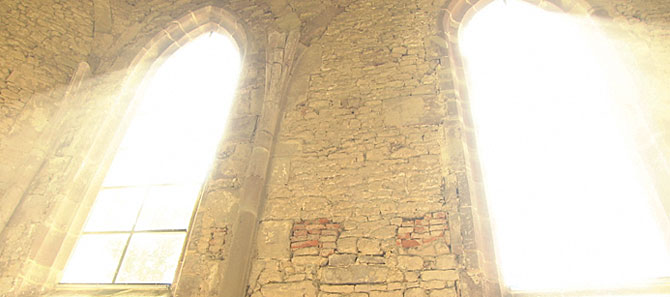
But sunlight is - just as fleeting as earthly life - changed, creates instantaneously always new perspectives and even measures the time... which constantly flees. It almost seems that the fades of the film wanted to reveal the secret of the power of light, because this gives power and energy - as with every life - only in the flow and the right dose.
And so, at that crystallization point on the east wall of the old church room, the I flows to the L I GHT on the trail of power. Energy from which wholesome life wells up: Without light no life.
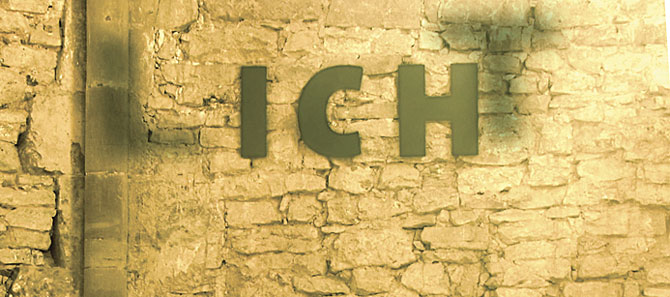
In the Romantic period, the "I" was still completely subordinated to the authority of the church and the earthly world was despised as an evil to be overcome. The Gothic man, on the other hand, could - in the mystical immersion while contemplating the light of the Gothic church rooms - also experience himself as an individual, an individual who is part of God's creation and who is able to establish a direct access to the divine on his own. Immaterial light, metaphysical phenomena, man before nature I therefore see as a theme for the chapel.
Valérie Hendrich and Beate Garmer, 2014
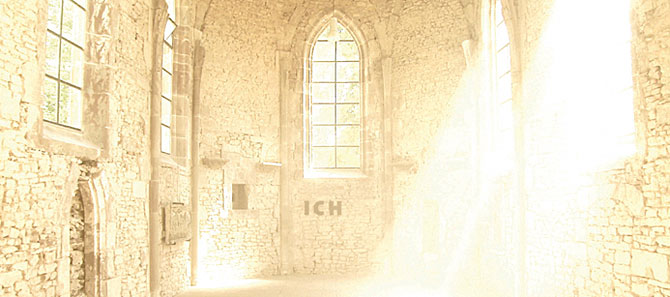
Living natural light
The film subtly plays with the origins of the light theology of the Gothic period, in the context of which a new building of the priory church also broke away from its Romanesque predecessor in the 15th century. The camera work repeatedly focuses on the stained glass windows and refers to a significant transformation that took place in medieval architecture, around the 13th century, from Romanesque to Gothic architecture. At that time, the cross-fertilization of progress in building technology on the one hand and light theology and light mysticism on the other led to an architectural revolution: the stone wall as the essential element of building dissolved into colored light walls. The incident earthly light is transformed into divine light by the light guidance of the windows and thus also brings about the "soul of the building". Light was an indispensable material in architecture. The special role of the light symbolism - finally leads in the architecture to highlights, to "cathedrals of light" as for example the cathedral of Metz.
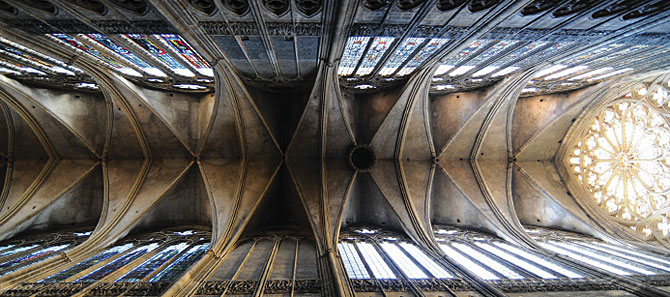
The theology of light in the Gothic period is represented by a "figure of light," Abbot Suger of St. Denis ("...How he enlarged the windows on the façade of his cathedral so that the room, which was somewhat dark in the old way, would shine with richer light..." From the Vita of Bishop Hugh, Chronicle of the Bishops of Auxerre c. 1180).
For the abbot, the church interior could only shine from its center. A place where natural light marries with divine light. Only the living natural light endures in Sugers light architecture. This was also the case with the (largely) new construction of the priory church of the Premonstratensians of Wintringen in the 15th century. The guidance of light through the new, much higher and pointed-arched tracery windows in the structure of the building played a role for the master builder that far exceeded the functional.
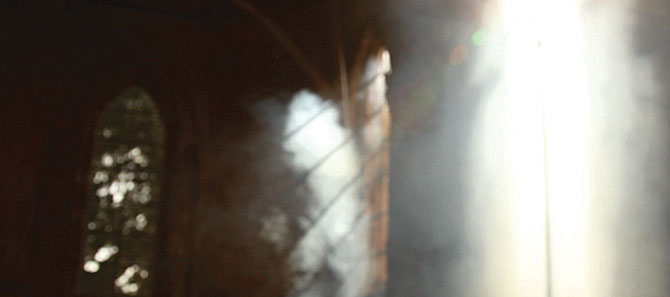
Overexposure
The fact that the film - albeit unintentionally - foreshadows the outlines of sculptor Hermann Bigelmayr's "broken wheat stalk" for a cut length in the "light fog" prompts me to link to the message of his installation "The Limits to Growth". Thus, the film and theme arguably also subliminally invoke the threat to the earth posed by underestimating the power of sunlight. Climate change comes to mind: due to the concentration of man-made pollutants in the atmosphere, the protective layer of the earth - the biosphere - is gradually being destroyed. Thus solar power becomes unintentionally destructive, "over-irradiated", leading to the greenhouse effect. The earth circle warms up unhealthily, drives up the climate worldwide, calls for survival art!
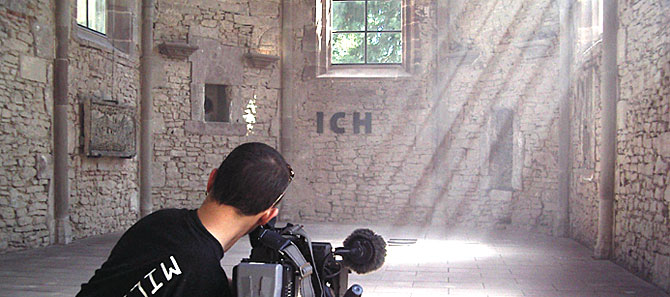
Imprint Film
LIGHT
A film by Valérie Hendrich
Sponsored by Saarland Medien GmbH and with the kind support of the Regional Association Saarbrücken
Based on an idea by Valérie Hendrich
Concept in collaboration with Beate Garmer and in exchange with Peter Michael Lupp, cultural site Wintringer Chapel
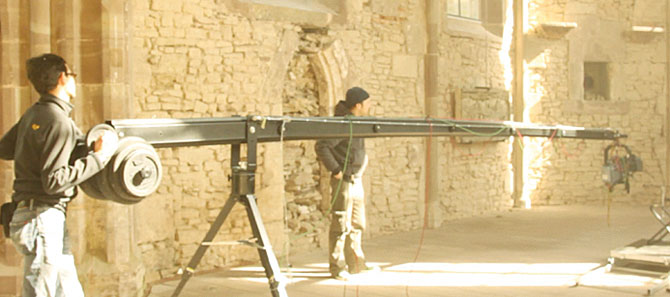
Director: Valérie Hendrich
Editing: Christian Schmidt
Camera: Stefan Kudzinski, Valérie Hendrich
Music: Chris Zabriskie
Graphics and color correction: Philipp Majer, Christian Schmidt
A contribution to the model project KulturOrt Wintringer Kapelle (extra muros). A place of art and culture in the Regional Association of Saarbrücken.

Biography
Valérie Hendrich, born 1973 in Forbach
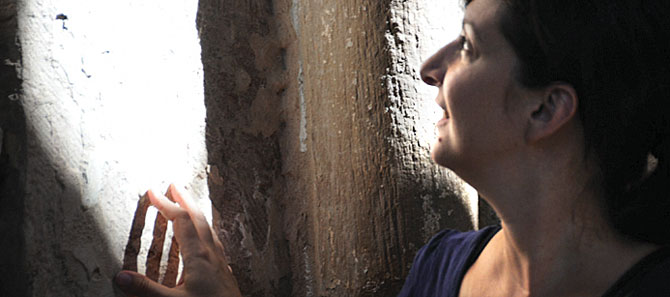
| 1993-1994 | Study of Liberal Arts at the école des beaux arts, Mulhouse with Prof. Tual |
| 1995-1999 | Studies of Free Art/Plastics with Prof. Wolfgang Nestler and Prof. Maria Nordman at the Hochschule der Bildenden Künste Saar, Saarbrücken |
| 1999 | Diploma and master student of Prof. Wolfgang Nestler |
| 2011 | Studio at Falkenhorst Castle, Kleinblittersdorf. Lives and works in France and Germany |
| 2013-2014 | Studio at the city hall square Saarbrücken |
Prizes/Awards/Scholarships
| 2011 | Film funding for the short film "Streiflichter", Saarland Medien GmbH, Saarbrücken |
Exhibition participation (selection)
| 2013 | Beautiful Arts #7, A nocturnal route through Saarbrücken workshops, July 2013 |
| 2012 | Drawing buffet, Kultur- und Werkhof Nauwieser Neunzehn, June 2013 |
| 2011 | 1001 Drawing reloaded in the shop windows, November 6-20 |
| 2011 | 1001 Drawing reloaded, drawing marathon to participate. September 24-25 |
| 2011 | loopingstar Videofestival, Studioblau of the Saarland House of Artists, Saarbrücken |
| 2011 | "double star" video installation, Kabinett Antik, St. Johanner Markt 18, Saarbrücken |
| 2010 | "1001 Drawing - Drawing Marathon", Gallery N.N., Nauwieser Neunzehn, Saarbrücken |
| 2010 | "The Blue Ribbon. Mirrored River - Reflections on the Saar", together with Designbüro Harald Hullmann & Jörg Gimmler, Saarufer, Saarbrücken, Völklingen, Sarreguemines, Hanweiler and Grosbliederstroff. |
| 2010 | "instigated!" 25 years Saarländisches Künstlerhaus - Saarland House of Artists, Saarbrücken |
| 2008 | "Gosz Rausch 3" Do you believe in Gosz, Museum Gosz, Saarbrücken |
| 2008 | "PAGE B", Museum Gosz, Saarbrücken |
| 2007 | "Gosz Rausch 2" 10 x 15, Gallery Gosz, Saarbruecken |
| 2007 | "100 Pictures for Monschau", An art project by Wolfgang Nestler, Monschau |
| 2006 | "Gosz Rausch" Christmas in the Gallery Gosz, Gallery Gosz, Saarbruecken |
| 2004 | "head drives blossom", schaubar exhibition space for art, architecture, design, saarbruecken |
| 2003 | Table Gallery, Institute for Contemporary Art, Saarlouis |
| 2002 | Table gallery, Handwerkergasse, Völklingen |
| 2002 | "at home", housing project, Saarbrücken together with Nina Jäger |
| 2000 | City Museum, Gelsenkirchen |
| 1999 | "projekt hügel", Krakòv (P) 1999 art gallery, Überherrn |
| 1997 | Hindenburg Tower, Riegelsberg |
| 1997 | Chun Chon gallery, Seoul |
| 1997 | Kunstverein Offenburg/Mittelbaden |
| 1997 | Museum Katharinenhof, Kranenburg |
| 1996 | "Reflections", Historical Museum Saar Bibliography |
Publications
| 2010 | Kunstlexikon Saar, Laboratory, Institute for Contemporary Art in Saarland |
| 2010 | The Blue Ribbon - The Saar Axis, Saarland Ministry for the Environment, Energy and Transport |
| 2010 | "instigated!" 25 years Saarländisches Künstlerhaus - Saarland House of Artists, Saarbrücken |
| 2006 | "sichtbar machen", State Art Schools in Saarland 1924-2004 Verlag St. Johann, Saarbrücken |
| 2002 | "zuhause", Living Space Project, ed. Nina Jäger Saarbrücken |
| 2002 | u201eForm shows itself\u201c, Saar University of Fine Arts, Handwerkergasse studio in the Völklingen Ironworks World Cultural Heritage Site, Monschau |
| 1999 | "diplom `99", ed. Walli Höfinger, Hochschule der Bildenden Künste Saar, Saarbrücken |
| 1999 | "Project Hill", Lipnica Murowana/Krakòv, ed. saoz, Krakòv (P). |
| 1999 | "Wiersze", Malgorzata Jurczak/Valérie Hendrich, eds. saoz, Krakòv (P). |
| 1999/ | "Der Freiheit ein Denkmal", ed. Kunstverein Offenburg/Mittelbaden |
| 1997 | "University of Fine Arts Saarbrücken", Verlag St. Johann GmbH, Saarbrücken |
